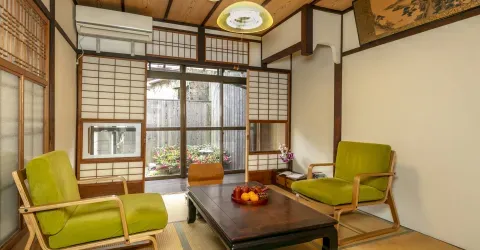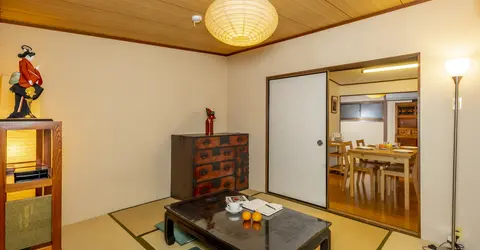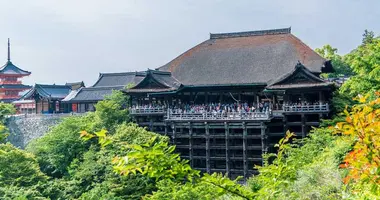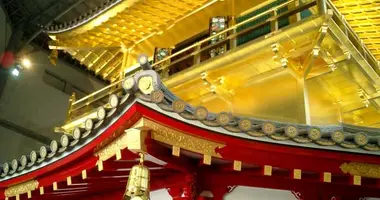Kyoto's Gion and Higashiyama districts
- Published on : 17/07/2020
- by : J.L.T.B. / J.R.
- Youtube
Discover traditional Japan in the most beautiful areas of Kyoto
In the heart of Japan's ancient imperial capital, the districts of Gion and Higashiyama embody the very essence of traditional Japan. These two emblematic areas of Kyoto offer a fascinating dive into a world where Japanese history, culture and aesthetics blend harmoniously. From cobblestone streets lined with machiyas to centuries-old temples and mysterious geishas, these neighborhoods invite you on a journey back in time to the heart of the Japanese soul.
Gion, the traditional heart of Kyoto
Gion, located between the Yasaka Shrine and the Kamo River, is Kyoto's most famous district. Famous for its geishas, called geiko in Kyoto, Gion offers a unique insight into traditional Japanese culture. Main streets such as Hanami-koji and Shinbashi dori are lined with machiya, traditional wooden houses that today house restaurants, teahouses and craft stores.
At dusk, Gion comes alive in a unique way. That's when you can spot the geiko and their apprentices, the maiko, on their way to their appointments in the ochaya (teahouses). Their presence, albeit discreet, adds a touch of mystery and elegance to the district's already enchanting atmosphere.
Gion's must-see sites include Yasaka jinja, a major Shinto shrine, and several important Buddhist temples such as Chion-in, Kennin-ji and Shoren-in. These places of worship, with their remarkable architecture and peaceful gardens, offer a striking contrast to the bustle of the shopping streets.
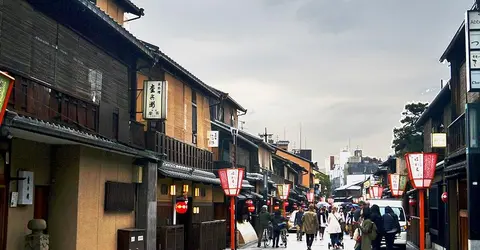
Hanamikoji street in Gion
Wikimedia Commons
Higashiyama, a journey through time
To the east of Gion, Higashiyama lies at the foot of Kyoto's eastern hills. This district is renowned for its well-preserved urban landscape, offering one of the most authentic images of old Japan. Higashiyama's winding cobblestone streets, including the famous Sannenzaka and Ninnenzaka, lead visitors through a maze of traditional stores, teahouses and ancient temples.
The jewel in Higashiyama's crown is undoubtedly the Kiyomizu-dera, a Buddhist temple listed as a UNESCO World Heritage Site. Perched on a hill, it offers spectacular panoramic views over Kyoto. The temple's wooden terrace, built without a single nail, is an architectural masterpiece that is sure to impress visitors.
Other remarkable temples dotted around the district include Kodai-ji, known for its Zen gardens and tea pavilions. The five-storey pagoda of Hokan-ji temple, visible from many points in the district, has become one of Higashiyama's symbols.
Must-sees
There are several sites in these two districts that deserve special attention:
- Yasaka jinja: This Shinto shrine is particularly spectacular at night, when its thousands of lanterns are lit.
- Kiyomizu-dera: In addition to its impressive architecture, this temple is famous for its spring of pure water, renowned for its healing properties.
- Kennin-ji: Kyoto's oldest Zen temple, renowned for its Zen gardens and mural paintings.
- Hanami-koji street: the heart of Gion, where you can admire traditional architecture and perhaps catch a glimpse of a geiko or maiko.
For a unique experience, we recommend taking part in a Gion Night Walk. This guided tour allows you to see the district in a different light and learn more about its history and traditions.
Art and culture at the heart of the neighborhoods
Gion and Higashiyama are hotbeds of traditional Japanese culture. The presence of geiko and maiko is one of the most visible expressions of this cultural heritage. These accomplished artists perpetuate centuries-old traditions of dance, music and etiquette.
Visitors can catch a glimpse of this art at seasonal festivals such as the Gion Matsuri, one of Japan's biggest, or at traditional dance performances such as the Gion Odori and Kyo Odori.
For fans of traditional theater, the Kyoto Kanze Noh Theatre offers the opportunity to attend performances of Noh, an ancient form of Japanese theater.
Culinary experiences and local shopping
Gastronomy is an important part of the experience in these neighborhoods. Gion and Higashiyama are packed with traditional restaurants where you can sample kaiseki cuisine, the most refined expression of Japanese gastronomy. Yatsuhashi, a local pastry made with rice flour and cinnamon, is a must for sweet tooths.
Shopping is also a popular activity in these districts. The streets are lined with local craft stores selling kimonos, fans, ceramics and other traditional objects. Kiyomizu-yaki pottery, a native of the region, is particularly sought-after by collectors.
Practical tips for exploring Gion and Higashiyama
To make the most of your visit :
- Plan your visit early in the morning or late in the afternoon to avoid crowds, especially during peak tourist season.
- Wear comfortable shoes, as most exploration is done on foot on cobblestone streets.
- Respect local etiquette, especially when taking photos. It is considered impolite to photograph geiko and maiko without their permission.
- Consult the local festival calendar to plan your visit around interesting cultural events.
For a more in-depth experience, consider taking part in one of the many Kyoto Activities on offer, such as traditional cooking classes or craft workshops.
Gion and Higashiyama offer an incomparable immersion in traditional Japan. Whether you're fascinated by history, architecture, culture or simply looking for a unique atmosphere, these neighborhoods are sure to enchant you and leave you with lasting memories of your stay in Kyoto.









